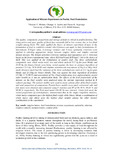Application of Mixture Experiments in Poultry Feed Formulation

View/
Date
2018-12Author
Sitienei, C. M.
Ayubu, Anapapa O.
Otieno, R. A.
Metadata
Show full item recordAbstract
The quality, components, proportions and storage of feeds is critical in poultry farming. The rising prices and poor quality of feeds has constantly led to low returns due to low final weights among birds. The study applied the theory of mixture experiment designs in the formulation of feed to establish a model which farmers can apply in their formulations. D-determinant, E-Eigen value, A-average variance and T-trace optimality criterions were applied in selecting appropriate design between simplex lattice and simplex centroid mixture designs. The designs selection criterions rankings had equivalence at 1.5. Selection based on the fewer experimental runs, where SLD had 6 and SCD had 7, led to the choice of SLD. This was applied in the formulation of poultry feed. The three carbohydrate components were whole maize meal, rice and wheat each at 51.7 kg for pure blends and 25.85 kg for binary blends were being varied against the base or primary ingredient of proteins (13.3 kg, 19 % DCP) and vitamins and minerals concentrate of 5kg in a 70kg chick mash. Growers mash had the variation of the three carbohydrates each at 51.1 kg for pure blends and 25.55kg for binary blends. This was against the base ingredient of proteins (11.9kf, 17 % DCP) and concentrate of 7kg. Final weights data were analyzed using second order models as it was an optimization study. The effects of the feed proportions of the mixture on the final weights were analyzed using the mixture regression method in R software package. The mixture models were used to create contour plots of the final weights and used proportion of components. Protein bases models (soya meal, cottonseed cake and fish meal) were obtained and compared using F-statistics and R2 of 98.74 %, 99.24 % and 99.98 % respectively. The Fish meal model (99.98 %) was selected. Under fish meal, the varied proportions of carbohydrates, demonstrated that in the single component mixtures, whole maize component gave the highest final weight while binary blends a combination of whole maize and wheat gave the highest final weights among the other mixture combinations in the experiment.
URI
http://ajest.info/index.php/ajest/article/view/389http://erepository.uoeld.ac.ke/handle/123456789/534
http://41.89.164.27:8080/xmlui/bitstream/handle/123456789/796/SITIENEI%20CHEPLETING%20MIRIAM.pdf?sequence=1&isAllowed=y
http://41.89.164.27:8080/xmlui/bitstream/handle/123456789/534/Sitienei%20Miriam.pdf?sequence=1&isAllowed=y
http://hdl.handle.net/123456789/4618
Collections
- Journal Articles (PAS) [285]
